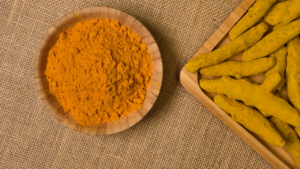Turmeric farming and business plan/हल्दी की खेती और व्यवसाय योजना
Turmeric (Haldi) has been a vital crop in Indian agriculture for centuries, widely used in food, medicine, and cosmetics. With rising demand for both yellow turmeric and black turmeric (Kali Haldi), various farming techniques such as organic farming, hydroponic cultivation, vertical farming, and polyhouse farming are now employed to improve yield, sustainability, and profitability.

1. Traditional Turmeric Farming (Haldi ki Kheti)
Haldi ki kheti, or turmeric farming, is most commonly practiced in tropical regions with loamy soil and moderate rainfall. Turmeric grows from rhizomes and requires 7-9 months to mature. The traditional farming method begins with planting during the monsoon, followed by harvesting from January to March. The cost of cultivation of turmeric varies but generally lies between ₹40,000 to ₹50,000 per acre.
Turmeric farming is profitable because the market demand for turmeric remains strong, especially in India. The haldi cost per kg fluctuates between ₹70 and ₹120, depending on quality, region, and seasonality. Haldi farming profit per acre can range from ₹60,000 to ₹80,000 under conventional farming methods.
2. Black Turmeric Farming (Kali Haldi ki Kheti)
Black turmeric (Kali Haldi) is a rare species with high medicinal value. Its cultivation is similar to yellow turmeric but requires specific care and attention. Kali haldi ki kheti can be more labor-intensive due to its delicate nature. The market for black turmeric is niche but lucrative, especially in the pharmaceutical and cosmetic industries.
Farmers interested in expanding into this sector often explore black turmeric contract farming, where companies provide the necessary inputs and secure a market for the crop at agreed prices. Contract farming reduces risk and helps farmers venture into the profitable yet volatile market of black turmeric.
3. Organic Cultivation of Turmeric
Increasing health consciousness has led to a surge in demand for organic turmeric farming. In organic haldi farming, farmers use natural fertilizers and pest control methods, enhancing the product’s appeal to health-conscious consumers. Organic turmeric cultivation requires a focus on soil health and crop rotation to avoid synthetic inputs. While it increases the cost of cultivation of turmeric, the premium price organic turmeric commands more than compensates for this.
4. Hydroponic and Soilless Turmeric Farming
Hydroponic farming of turmeric is a modern cultivation technique that allows turmeric to be grown without soil, using nutrient-rich water solutions. Hydroponic turmeric cultivation ensures higher yields in smaller spaces and eliminates many soil-related challenges. Farmers practicing hydroponic turmeric farming can control environmental conditions, leading to faster growth cycles and disease-free crops. This method is particularly suited for areas with poor soil quality or urban farming initiatives.
5. Vertical Farming and Polyhouse Turmeric Farming
Vertical farming of turmeric and turmeric farming in polyhouses are innovative approaches to maximize yield per square foot. Turmeric vertical farming involves growing crops in stacked layers, allowing farmers to use limited space efficiently. The cost of vertical turmeric farming may initially be higher due to infrastructure investments, but the long-term benefits of higher yield and reduced water usage make it economically viable.
Polyhouse turmeric farming provides a controlled environment, shielding the crop from unpredictable weather conditions and pests. By maintaining optimal temperature, humidity, and light levels, farmers can grow turmeric throughout the year, leading to higher profitability.
6. Profitability of Turmeric Farming
The profitability of turmeric farming depends on several factors, including cultivation method, cost management, and market demand. The turmeric cultivation cost per acre is generally ₹40,000-50,000, while turmeric farming profit per acre can reach up to ₹60,000-80,000 in conventional farming. Organic turmeric farming tends to fetch a higher price in the market, leading to even greater returns.
In modern farming setups such as turmeric hydroponic farming and vertical farming, while the cost of vertical turmeric farming may be higher, the efficient use of space and controlled environment leads to faster crop cycles, reducing the overall cultivation time and enhancing profits.
7. Turmeric Contract Farming
Turmeric contract farming is gaining momentum in India, allowing farmers to reduce risks associated with fluctuating market prices. In contract farming, farmers enter into agreements with buyers—usually companies in the pharmaceutical, food, or cosmetic industries—that guarantee the purchase of their crop at pre-determined rates.
Conclusion
Turmeric farming (Haldi ki kheti) remains a highly profitable venture, especially with modern techniques such as organic farming, hydroponic cultivation, and vertical farming. The choice of farming method depends on available resources, climate, and market demand. Whether opting for traditional or modern techniques, farmers can expect substantial returns by leveraging innovation and focusing on sustainability.

